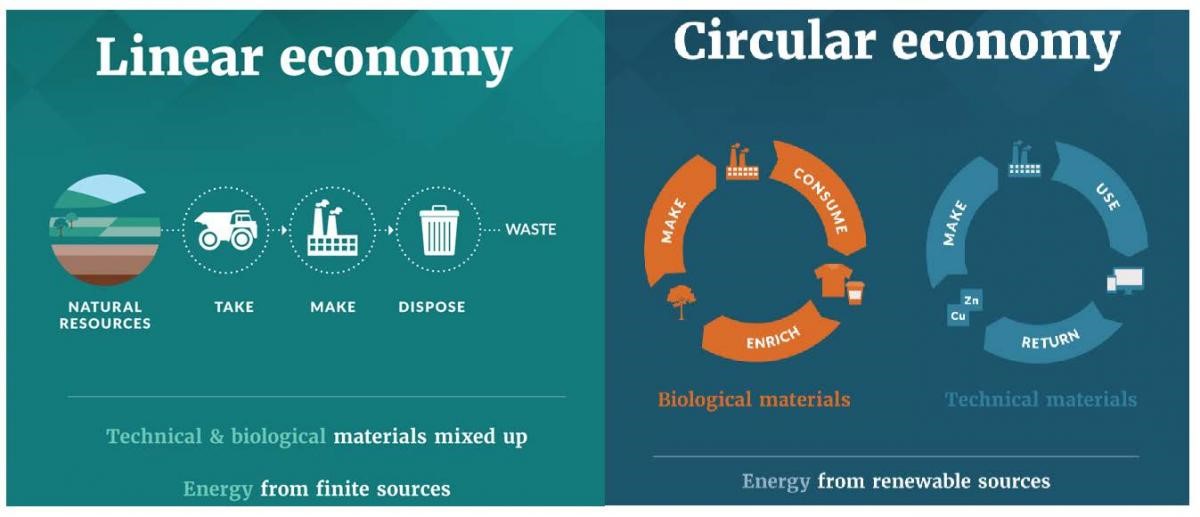Energy, farming, and the circular economy
The 2020 Budget left $20 billion to be allocated for future investment. How should the Government invest the remaining the $20 billion?
This is the last article in a three-part series that argues that the Government should invest in projects that address New Zealand’s most pressing intergenerational challenges: Inequality, climate change, and infrastructure.
The first article examined some ideas for renewable and decentralised energy. The second article highlighted the ways that regenerative and distributed farming could support a flourishing social foundation and a healthy planet. This article looks into the circular economy; one that is restorative and regenerative by design.
The Ellen MacArthur Foundation defines the circular economy as “a circular economy is based on the principles of designing out waste and pollution, keeping products and materials in use, and regenerating natural systems”. As shown at Figure 1, the circular economy takes a regenerative approach rather than the traditional linear approach. The circular economy keeps resources in use for as long as possible, while the linear economy products are not designed for reuse and usually end up in the landfill.
Figure 1 - Circular economy

We need to re-think and re-imagine supply chains and systems that are used for production and distribution of goods and services.
Achieving New Zealand’s net zero emissions target by 2050 (as set by the Climate Change Response (Zero Carbon) Act 2019) requires transitioning to a circular economy. We need to re-think and re-imagine supply chains and systems that are used for production and distribution of goods and services. Changes are required throughout the entire supply chain: design, manufacturing, packaging, warehousing, transport, marketing, consumption, etc. We need to move towards supply chains that prevent and reduce waste, and facilitate reusing resources.
Significant investment is required to transition towards circular systems. There are various projects or legislation changes that the Government could promote to help this, such as:
- Investing in infrastructure that supports supply chains to reduce and reuse
- Investing in technology
- Incentivising manufacturing that applies eco-design principles and circular economy innovation
- Implementing regulation for product stewardship
- Supporting and incentivising SMEs to use use circular products and packaging
- Creating repair community hubs
- Supporting waste to new materials initiatives
- Implementing composting services
- Investing in products as a service.
Further ideas can be found in the Amsterdam Circular 2020-2025 Strategy.
The circular economy would ensure regenerative production and consumption, which ultimately supports a healthy planet. But it can also positively impact upon inequality if it is implemented in a manner that increases access to goods and services for all. One approach for reducing inequality is the sharing economy. The sharing economy, a concept within the circular economy, is about access to goods and services. There are already many examples globally and in New Zealand, such as renting clothes, peer-to-peer accommodation, and Netflix. The devil will be in the detail as to whether the sharing economy increases accessibilty of goods and services. One approach could be new public sharing initiatives, such as ‘public libraries’ for goods.
For the circular economy to support equality and improve accessibilities also depends on who gets the resources. The Government could fund iwi to implement Māori-led projects, as well as funding local councils or other community entities. Investment by the Government to ensure a digital ready New Zealand is also fundamental for improving accessibilty.
As we rebuild our economy with a significant investment, we also need to rebuild with significant structural changes to the systems that govern our lives.
As we rebuild our economy with a significant investment, we also need to rebuild with significant structural changes to the systems that govern our lives. New Zealand’s inequality and climate change challenges will not be overcome without ensuring that our systems are based on all New Zealander’s values, ideas, and knowledge.
Investing in the suggested projects (energy, farming, and the circular economy), in a way that honours Te Tiriti o Waitangi, would support or create jobs, communities, businesses, and markets that contribute to solving New Zealand’s intergenerational challenges. But for the $20 billion to be truly transformational for our people and our planet, structural change that is reflective of all New Zealanders is required.